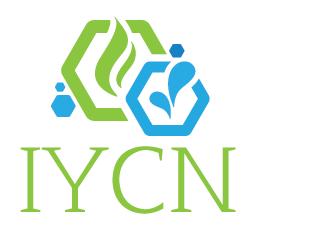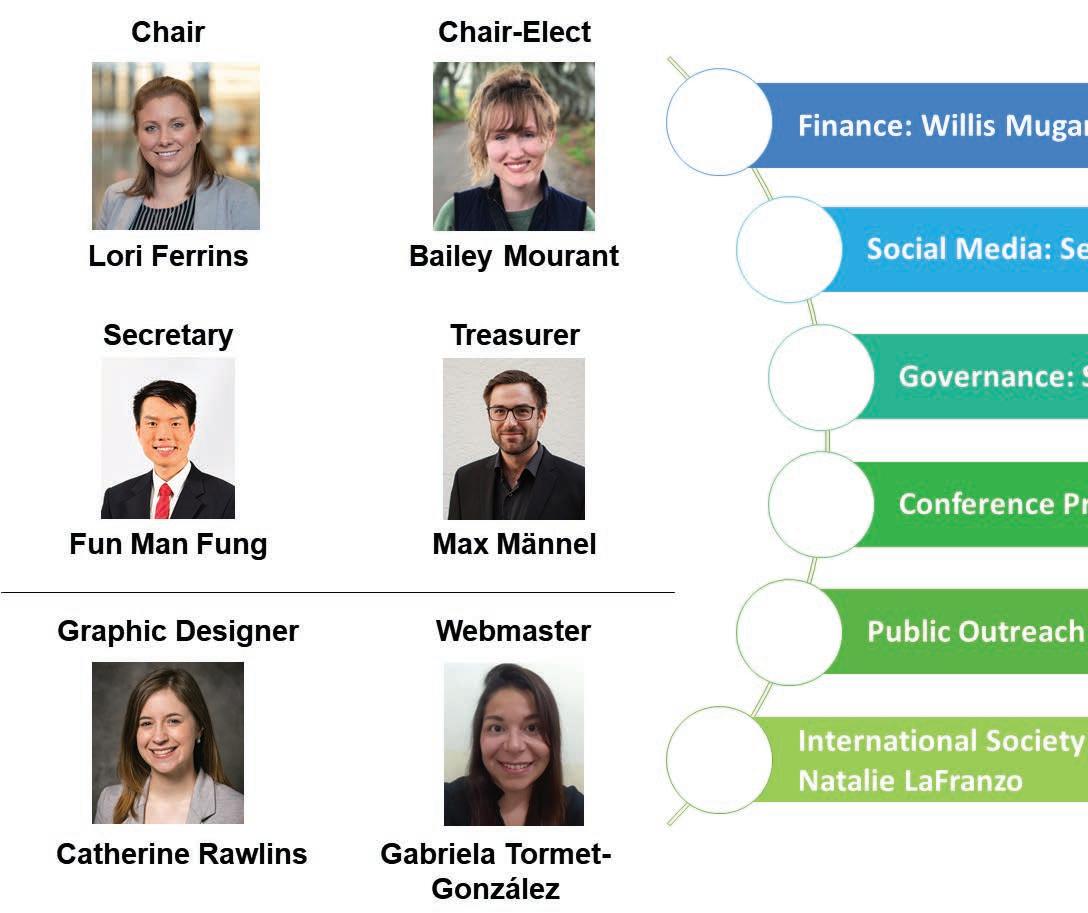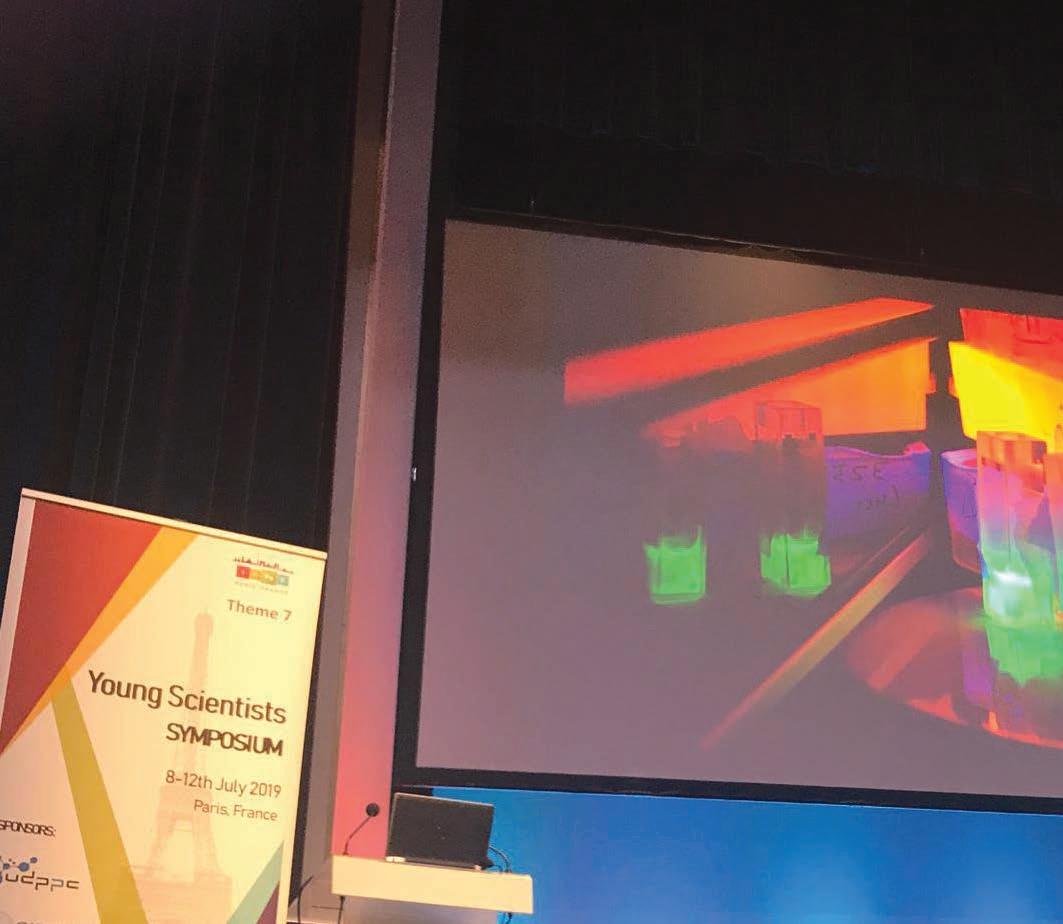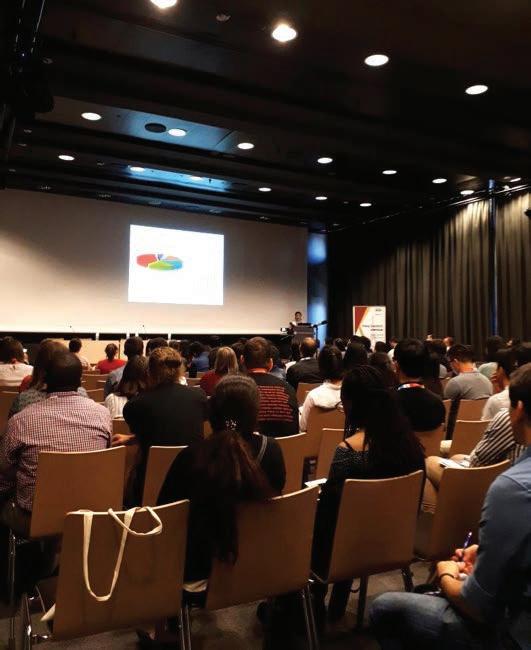
14 minute read
A Global Discourse on the Future of Chemistry
The Inaugural IYCN General Assembly
by Bailey Mourant, Lori Ferrins, Sophie Carenco, Natalie LaFranzo, and Catherine M. Rawlins
The International Younger Chemists Network (IYCN) began as a task force at the 2015 ACS National Meeting in Boston between a group of young chemists from the USA, Africa, Southeast Asia, and Europe. The ultimate goal was to create a unified international network for younger chemists to connect and share ideas. Successful efforts led to the official launch of IYCN as an associated organization of IUPAC at the 46th World Chemistry Congress (IUPAC2017) held in Brazil.
We are a global network working to establish a platform that fosters communication, mentorship, and collaboration between our members, and our recently updated vision statement is refl ective of this (connect and empower younger chemists globally). Our social media accounts have grown exponentially since the inception of IYCN and we currently have in excess of 2,800 followers across all channels. This is proving to be a valuable way for us to connect with younger chemists and to bring opportunities to their attention!
Our membership base includes any chemist under the age of 35 or someone within 5 non-continuous years from their terminal degree, or training. As a result of feedback during our strategic planning session, we have established an online membership page where you can join IYCN and let us know if you would like to take on a more active role within the network. It is important to note that membership of IYCN is free! Go to: www.iycnglobal.com/membership to join now!
Whilst IYCN is not the younger chemist branch of IUPAC, IUPAC does continue to of er guidance and support in our everyday activities. We provide opportunities for younger chemists who are active within IYCN to interact with IUPAC, and we promote ways in which people can get involved in many of the IUPAC projects (such as updating the gold and orange books).
General Assembly
In July 2019, and after much anticipation, IYCN hosted its inaugural General Assembly (GA); a daylong meeting held in conjunction with the IUPAC biennial General Assembly, which gathered young chemists from all over the world to determine the future direction of the organization.
The delegation consisted of 43 members from 33 countries, with no more than two delegates from the same country. Observers also attended and actively contributed ideas throughout the GA, but were not permitted to vote. Both in-person and virtual attendance was possible on the day, and the event boasted a nearly-even, 52 % male and 48 % female, split of attendees.
In the morning, IUPAC Vice President, Christopher Brett, and IUPAC Secretary General, Richard Hartshorn, addressed the delegation with a warm welcome and emphasized the important role that IYCN and its members will play in the future of IUPAC. The first half of the GA was dedicated to electing the 2019-2021 Executive Board and finalizing IYCN’s Statutes & Bylaws. The latter half of the day consisted of a strategic planning session, which reformulated IYCN’s Vision and Mission statements and established short-term and medium-term goals, which will direct the activities of each steering committee in the coming years.

Statutes & Bylaws
IUPAC2017 provided an opportunity for IYCN members to meet, and the Governance subcommittee was formed, with a focus on being an international and intercultural team of volunteers. They began working on the Statutes & Bylaws of the network.
The requirements were as follows: (1) Statutes should make IYCN a truly representative group of younger chemists, able to carry the voice of international researchers, students, teachers and workers, (2) IYCN should have “built-in” diversity in terms of country of origin, country of work, and diversity, (3) it should be accessible, both financially and geographically, (4) Statutes & Bylaws should give the network a robust yet flexible structure, in order to give credit to its long-term goals, (5) last but not least, IYCN should be attractive to younger chemists as well as to more experienced partners in order to maximize its potential and outputs.
In order to address point (1), we adopted a traditional two-body structure, with a legislative body and an executive one (as can be found in IUPAC); the first one electing and providing oversight of the latter. It should be noted that the executive body has no say in the designation of the delegates: these are chosen within each country according to their own rules and preferences (guided by national chemical societies, if there are any), in a process that minimizes interference from IYCN. (2) is ensured by constructing the legislative body from countries (like IUPAC) rather than from societies, and by giving the same voting rights and weight to every country (unlike IUPAC). Regarding (3), there is no fee for membership, and virtual attendance at the GA was declared valid. (4) and (5) are supported by the fact that members can propose new activities and projects, and the number of steering committees is not constrained. The Bylaws are easier to modify than the Statutes, which is both protective for the organization but still ensures the flexibility to improve legislation which is not effective. Moreover, we of er the possibility to chemists who do not meet the membership requirement to contribute to the network via the “senior contributors” position.

The 2019-2021 IYCN Executive Board (upper-4), Non-Voting Contributors (lower-2) - SEE more in FULL text
The draft of the Statutes & Bylaws were sent to all delegates and discussed during the GA during a session facilitated by one of our members, Dr. Sophie Carenco. Some majors points were addressed, a consensus was found, and improvements to the draft were made on the spot.
As expected, the definition of “younger chemists” required some focusing. Depending on the regions of the world, attendance at university happens at a broad range of ages and studies may be interrupted by working periods.
The role of the Vice-Chair was also tricky to delineate: while continuity is clearly an advantage for the network, we had to anticipate that, for early-career chemists, long-term commitment is more delicate to achieve than at later stages of their career. It was finally decided that the Vice-Chair would act as the Chair-Elect while requiring the approval of the Executive Board before being directly appointed (without an election) as Chair for the next term.
The relations between the Treasurer and the Finance committee were clarified: while being a full member of the Executive Board, the Treasurer cannot be the committee leader. This insures that at least two people sit on the Executive Board and have to answer for how the money is collected and spent.
The finalized version of the Statutes & Bylaws was sent to the 43 delegates and approved unanimously. These are freely available to download on the IYCN website www.iycnglobal.com.
Strategic planning session
High-functioning, inspirational organizations all have common themes: a compelling mission, a clear vision, and designated time to strategically plan how to accomplish their goals. As an organization still in its infancy, the IYCN had previously been operating in a more reactionary environment, with room to become more strategic in how time and resources were allocated. One of the major accomplishments of the 2019 GA was an accelerated Strategic Planning Session to ensure a sustainable and impactful future for IYCN.
The preparation and execution was modeled after the American Chemical Society’s highly successful Strategic Planning Course. Delegates completed prework in the form of a survey, where they were asked to brainstorm new mission and vision statements, and goals for IYCN for the next 2-5 years. Facilitated by Dr. Natalie LaFranzo, the delegates were asked in real-time to reflect on the accomplishments and structure of IYCN thus far. This information, in addition to the survey results, were summarized and reviewed to lay the groundwork for finalizing new vision and mission statements. With robust discussion from the room, the following were adopted:
Vision Statement: Connect and empower younger chemists globally.
Mission Statement: The International Younger Chemists Network (IYCN) supports and advocates for younger scientists working across the chemical sciences to promote a globally sustainable future.
Important to note was the desire to capture our membership-focus: connecting and empowering our members, and to ensure that the UN’s Sustainable Development Goals are central to IYCN’s mission.
The final task during the session was to outline a framework for building goals around the newly crafted vision and mission, with a focus on SMART (Specific, Measureable, Achievable, Realistic and Time-bound) goals. Interestingly, the majority of the goals drafted during the session were directly aligned with the subcommittee structure that was already in place. These goals have since been delegated to Steering Committee Leaders, who will now be responsible for setting up tactical execution in an effort to expand IYCN’s reach and impact! The status of these goals will be evaluated regularly to ensure the teams are on track, the goals are prioritized based on relevancy and resources, and any challenges are addressed.
The results of this Strategic Planning Session serve as a roadmap for the organization, and we look forward to measuring their impact!
Other events at IUPAC2019
In addition to the GA, IYCN organized and co-organized several activities at the IUPAC World Congress. Monday evening, in collaboration with IUPAC, there was a Speed Networking session combining younger chemists and leaders of different IUPAC Divisions and Committees to learn about the opportunities within the organization. Networking continued with a poster session and mixer featuring young chemist posters and IUPAC posters sponsored by the Royal Society of Chemistry and the American Chemical Society, International Activities Committee. Additionally, we hosted a reception with the Australian Academy of Sciences (AAS) to showcase Australian chemistry research, highlighting industry and research opportunities, and providing an environment fruitful for networking. Tuesday featured the IYCN organized symposium titled “The International Younger Chemists Network (IYCN): Shaping the Future Worldwide” and speakers from the IYCN board and other international young chemist organizations. Dr. Cecilia Roque from the Faculdade de Ciencias e Tecnologias at the Universidade Nova de Lisboa (FCT/ UNL) was the closing keynote speaker. Wednesday we hosted a lunchtime “CV Clinic” workshop featuring Robert Bowles from the Royal Society of Chemistry where attendees had the opportunity to review each other’s CVs and learn how to tailor them for a specific job description. On Thursday IYCN co-sponsored a panel with Afriscitech called “Redefining Scientific Excellence in Africa” which featured professionals from different parts of the continent sharing their experiences and expertise. It was thanks to the French Young Chemists’ Network (RJ-SCF or Réseau des Jeunes Chimistes of the French Chemical Society) that IYCN had such strong visibility at IUPAC, they included us in the planning and organizing of the Young Scientists Programme and we are grateful for their generosity.

The structure of IYCN as finalized after the ratification of the Statutes and Bylaws, highlighting the legislative and executive branches and how these two bodies interact to drive IYCN.
What’s next for IYCN?
We are currently working towards developing strategies to achieve the goals that were set during our strategic planning session and we will be announcing our plans in the coming months. But, we are already working on other exciting projects; we will again be hosting an experiment competition, giving you the opportunity to develop an experiment around a specific theme • the winning entry gets a cash prize and their experiment is translated and made freely available through the IYCN website! We are still in the planning stages but more details will be released soon!
Please follow along with us via social media as we continue to grow. You can subscribe to receive updates from our website (www.iycnglobal.com), as well as get regular announcements through Twitter (@IntlYoungerChem), Facebook (@IYCN.global) and LinkedIn (intlyoungerchemistsnetwork). Finally, we are already looking forward to IUPAC2021 in Montreal, and we hope to see many of you there!
Cite: Mourant, B., Ferrins, L., Carenco, S., LaFranzo, N., & Rawlins, C. M. (2020). The Inaugural IYCN General Assembly, Chemistry International, 42(1), 16-19; https://doi.org/10.1515/ci-2020-0105
From Young Attendees to Young Actors: The “Young Chemists Symposium” at IUPAC2019
by Sophie Carenco et al.
For 100 years, IUPAC has supported chemists worldwide in all facets of their craft: industrial development, academic research, teaching, and many more. Mindful of nurturing its future leaders, since 2020 the Union ensured the attendance of the younger generation of chemists at the General Assembly and Congress in part through their “Young Observers” program [1]. It provides an opportunity for scientists below 40 to acquaint themselves with the work of the Divisions and Committees. The IUPAC Congress, which attracts several thousand attendees every two years, was not finely tuned to the expectations and contributions of the rising generation of chemists. However, the paradigm has begun to change. For the 47 th Congress organized in Paris, France, 5-12 July 2019, the scientific executive committee, chaired by Clément Sanchez, enthusiastically received the proposal from a team of young chemists to build a “Young Chemists Symposium”, organized by younger chemists for the benefit of all the attendees.

Organization of the symposium started two years earlier under the leadership of Camille Oger, assistant professor at the University of Montpellier and a former board member of the RJ-SCF (the French young chemists network) [2] and the European Young Chemists Network (EYCN) [3]. In order to foster international collaboration and intercultural cooperation, other networks were invited to contribute to the symposium organization: the International Younger Chemists Network (IYCN) [4], EYCN, and Afriscitech [5]. The sessions were open to all attendees.
In addition to an opening networking session with poster presentations, six sessions were hosted in the symposium: • “From the bench to the market” with testimonies from entrepreneurs, was especially appreciated as it unraveled the do’s and don’ts of a start-up business; • “Scientific writing” with contributions from the European Research Council (ERC) executive agency, a journal editor and a writing coach, was well attended by attendees at all stages of their career; • “Teaching” was enlightening to all by demonstrating new, stimulating practices in countries such as Singapore, Netherlands and France; • “New channels and challenges for scientific outreach” illustrated how Youtube and the digital world could rejuvenate the field;

Young Chemist Symposium at the Palais des Congrès, Paris
An IYCN-centered session brought together younger chemists from around the world and was focused around professional development and the personal success stories of empowered young leaders in chemistry;
“Redefining scientific excellence in Africa” highlighted, from the point of view of three researchers from this continent, how research could be better appreciated in countries where it is still not enough developed.
The symposium was complemented by other events that brought young chemists together. This included a tour of Paris’ historical sites around the life of Marie Skłodowska-Curie as a social event (provided by the association “Parcours des Sciences” [6]). The IYCN offered a CV-clinic during one of the lunch time sessions that featured Robert Bowles of the RSC leading the discussion, and a Q&A style discussion with Michelle Lucas and Georg Wießmeier from Sibelco. Lastly, a special evening event was organized to foster discussions between the younger chemists from the conference and these from the Paris area. Held in the grand auditorium at la Maison de la Chimie, it dealt with “young chemists and politics”, with two VIPs: Zhenan Bao from Stanford University and Ken Xie from the Australian Embassy in Paris. During the evening, the winners of the “Chemistry Rediscovered” video contest organized by EYCN were presented [7].
Overall, more than 20 speakers contributed to the symposium, which gathered a large number of attendees from academia, industry and teaching, in the 100-seat modern room of the Palais des Congrès. It was covered live through a dedicated twitter account (@YoungSci_IUPAC) whose audience rapidly reached 600 followers. It also effectively served as a meeting point for active members of younger chemists’ networks, for young observers, as well as for the IYCN delegates who participated in the congress, thus fostering unique opportunities for the younger generations to connect with the IUPAC community. As the first of its kind, gathering funding was challenging for such an innovative event. Fortunately, several partners contributed to allow the symposium to take place, including IUPAC, Fondation de la Maison de la Chimie, UdPPC, Sibelco, Evonik, ACS, RSC, SCF, GDCh and IYCN.
In conclusion, the “Young Chemists Symposium” managed to address topics not covered by the rest of the congress (e.g. entrepreneurship), and to provide original viewpoints on other issues (e.g. teaching, outreach, young chemists in politics) for the benefit of all attendees. Let us hope that this is the beginning of a new era for IUPAC Congresses and similar program will be staged in Montreal during the 2021 Congress, in one form or another.
References
1. E. P. Przybylowicz, Chem. Int., 24(1):7-9 (2002) https://doi.org/10.1515/ci.2002.24.1.7
2. http://www.societechimiquedefrance.fr/About-the-RJSCF.html
3. https://www.euchems.eu/divisions/european-youngchemists-network/
4. https://www.iycnglobal.com/
5. https://afriscitech.com/
6. https://parcoursdessciences.fr/
7. https://www.euchems.eu/divisions/european-youngchemists-network/chemistry-rediscovered/
Contributors include from the Société Chimique de France (SCF): Camille Oger, Victor Mougel, Stéphanie Halbert, Sophie Carenco, Lydia Sosa-Vargas, and Benjamin Poggi; from the International Younger Chemists Network (IYCN): Lori Ferrins, Bailey Mourant, and Catherine Rawlins; from the European Young Chemists Network (EYCN): Antonio M. Rodríguez, Alice Soldà, and Maximillian Menche; and from Afriscitech: Luc Allemand
Cite Chemistry International 2020, 42(1), 20-21; https://doi.org/10.1515/ci-2020-0106






